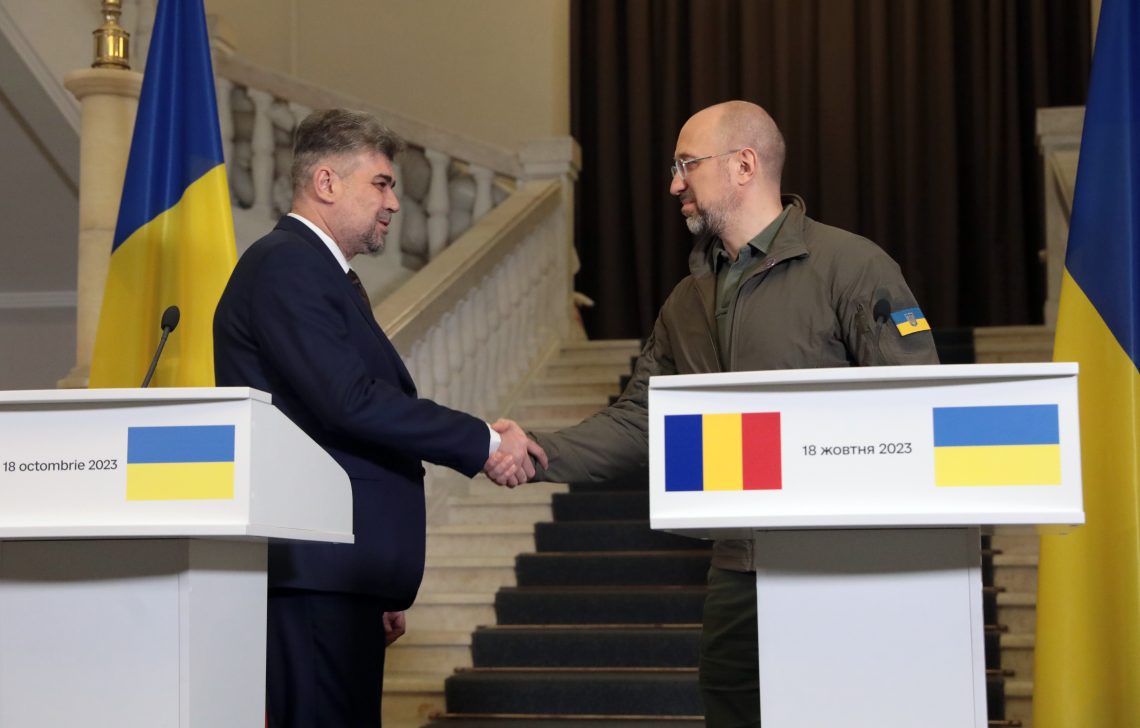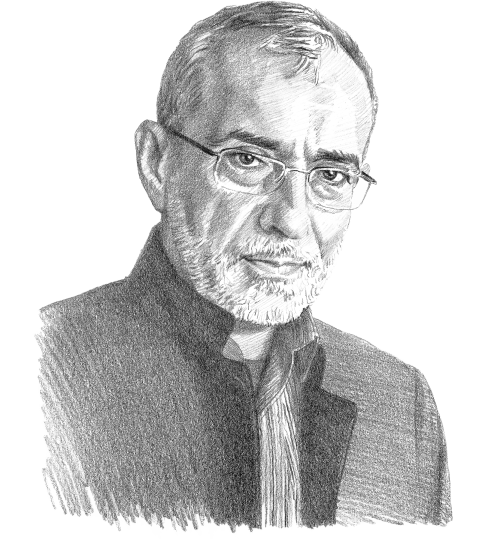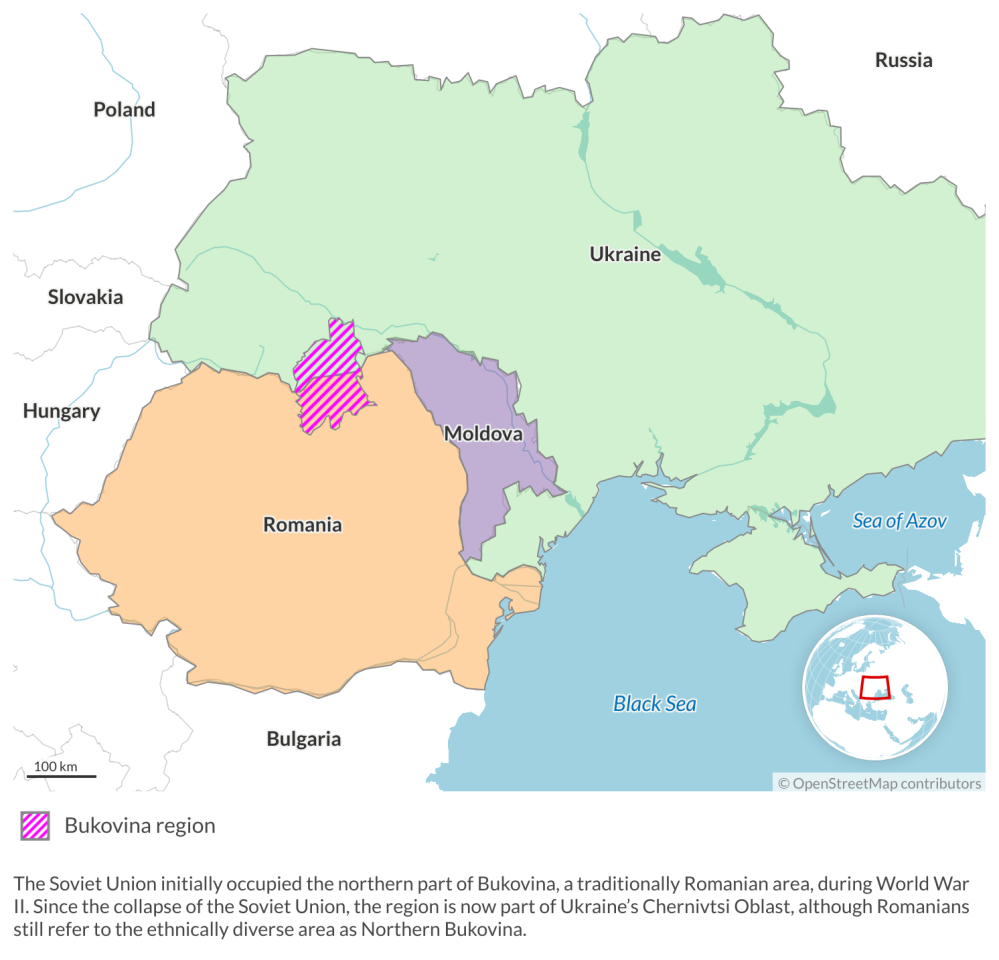Frictions aside, Romania remains steady in support of Ukraine
Despite historical tensions over minority rights and territorial disputes, Romania has shown unwavering solidarity with Ukraine in its defense against Russia’s invasion.

In a nutshell
- Romania has pragmatically navigated its Soviet-era grievances with Ukraine
- The future of the bilateral relationship will be shaped by the war’s outcome
- Ukraine’s successful European integration could deliver regional benefits
A national survey of the Romanian population, conducted by the Romanian Institute for Evaluation and Strategy (IRES), found that 62 percent of respondents wanted their country to continue supporting Ukraine in its ongoing conflict with Russia. The survey was taken one year after Moscow launched its large-scale war in Ukraine on February 24, 2022.
A more recent survey, “Transatlantic Trends 2023,” released by the German Marshall Fund in September 2023, confirmed that over half of Romanian citizens support Ukraine’s accession to NATO and the European Union, with 60 percent in favor of providing financial assistance for its reconstruction after the war. An opinion poll conducted by INSCOP Research from Bucharest during the same month echoed these findings: 40 percent believe that Ukraine will win and 63 percent think Russia should end the war by withdrawing from Ukrainian territories that its forces occupy.
Overall, these surveys consistently document robust support for Ukraine in Romania. The initial sympathy and enthusiastic aid offered by Romanians at the onset of the war, through self-organized efforts to welcome refugees and provide assistance, have not diminished. Both the country’s elites and public have remained steadfast allies to Ukraine throughout the conflict.
The reality captured by the surveys might not seem surprising, given the strong emotional and intuitive appeal of the Ukrainian cause in the region. However, considering the nontrivial points of friction and diplomatic unease between Bucharest and Kyiv before the Russian invasion, the remarkably consistent and steady Romanian support warrants further discussion.
Read more by Paul Dragos Aligica
Romania-Moldova reunification: Three scenarios
Romania’s paradox
Reconstructing the postwar Black Sea region
Tensions in the Ukrainian-Romanian relationship
Turning to the background of disagreements, several issues have strained the otherwise positive relationship between Romania and Ukraine in the post-communist period. They are all rooted in the historical and geopolitical actions of the Soviet Union. While no major political force in Romania has shown the capacity or willingness to mobilize around these issues, a palpable sense of resentment has been evident. This sentiment stemmed from the perception of Ukraine as either an unjust beneficiary of territories that Romania has lost since World War II and the dissolution of the Soviet Union, or as a state perceived as being unsympathetic and intolerant toward the Romanian minority within its borders.
Preservation of the Romanian language in Ukraine
One of the most salient aspects in this regard centers on the protection of the rights of the Romanian minority in Ukraine, particularly concerning the preservation of Romanian language education in local schools. An estimated 150,000 to 500,000 ethnic Romanians live in Ukraine.
Whether Ukraine has consistently acted in good faith regarding these minority rights has remained an ongoing question for Bucharest. Compounding this point is Romania’s rejection of the distinction, one that it considers unacceptably artificial, between Romanian and Moldovan identities and languages. Yet this distinction has been perpetuated by Ukraine since the Soviet era.
Since Ukraine’s independence and the signing of the 1997 treaty on the relations of good neighborliness and cooperation between Romania and Ukraine, an intergovernmental commission has been established to address the rights of Romanian and Ukrainian minorities in their respective states. This commission meets annually, demonstrating ongoing efforts to tackle these sensitive issues. However, the situation of the Romanian minority in Ukraine has grown more complicated since Russia’s initial invasion of Ukraine in 2014 following the Euromaidan Revolution that sent Kremlin-backed Ukrainian President Viktor Yanukovych into exile in Russia. Ukrainian endeavors to define and consolidate its national identity in the post-Soviet era, aimed at distancing itself from Russian influence, have inadvertently affected non-Russian minorities, including Romanians and Hungarians, who are concentrated in Ukraine’s western Zakarpattia Oblast.
The 2017 Ukrainian Education Law, which restricts education in minority languages to primary schools and mandates the use of Ukrainian at higher education levels, has been a particular point of contention. While intended to unify and assimilate the population, and counter Soviet-era Russification, the law has also affected the linguistic rights of other minorities. This has drawn criticism from both the Romanian minority and Bucharest. The challenge for Kyiv lies in diminishing Russian influence without infringing upon the rights of other ethnic groups, a balancing act that continues to provoke debate and protest within minority communities in Ukraine. This is the context in which President Volodymyr Zelenskiy announced the signing of the revised law on national minorities on November 3, 2023. This amendment aligns with one of the seven recommendations made by the European Commission in June 2022, as part of Ukraine’s efforts to join the bloc.
Facts & figures
The unresolved territorial issues of Northern Bukovina
However, all the above are mere outgrowths of the territorial problem. In addition to Northern Bukovina (a traditionally Romanian region, now part of Ukraine’s Chernivtsi Oblast), several other territorial aspects have been noticeable and may become even more relevant in setting the tone of the relationship between the two countries in the future.
The first issue dates to the Soviet era, when Moscow contested the Romanian-Soviet border established along Chilia, one of three main distributary channels of the Danube River, in 1940. Initially based on the Chilia arm, this boundary shifted due to the Soviet occupation of strategically important islands. Although a protocol was signed in 1948, it was never ratified by Romania. The Frontier Treaty of 1961, also unratified, left these issues unresolved until the 1997 Frontier Treaty with independent Ukraine. This agreement was essential for Romania’s NATO membership bid in 2003. Even today, Romania opposes Ukraine’s intention to include the Chilia arm in the TEN-T network (Trans-European Transport Network), arguing that the Chilia arm is neither deep enough nor suitable for heavy-tonnage ships.
The dispute over Snake Island and Bystre channel
Another notable territorial dispute concerns Snake Island and its environs in the Black Sea, occupied by the Soviet Union in 1940. Soviet possession was reaffirmed in 1961 and later inherited by Ukraine. The discovery of gas resources near the island escalated tensions, leading to a prolonged dispute over maritime boundaries. In 2009, the International Court of Justice ruled largely in Romania’s favor, recognizing its sovereignty over a significant portion of the disputed area.
Environmental and geomorphological factors have also fueled disputes. The Danube Delta, continually changing due to geological processes, has made border demarcation challenging. A 2003 treaty attempted to address this by setting the border at the midline of the fairway, or navigable part, but changes in the area’s geography have led to further disagreements.
The Bystre channel dispute adds another layer of complexity. Ukraine’s project to divert navigation from the Romanian Sulina channel to the Chilia channel has been criticized for its environmental impact and potential harm to the Danube Delta, a UNESCO World Heritage site.
Facts & figures
Despite disagreements, Romania’s support of Ukraine remains strong
Yet, despite these frictions, the historical and environmental disputes have not significantly diminished Bucharest’s support for Kyiv. This is most evident regarding Ukraine’s reliance on Romanian transit routes for exports. Most redirected Ukrainian exports now transit the Sulina Channel, the Romanian port of Constanta on the Black Sea or the adapted Romanian railway segment at the Galati port.
On a broader scale, Romania’s diplomatic efforts consistently support the Ukrainian cause, and – as we have seen – the Romanian public overwhelmingly endorses the pro-Ukraine stance of its diplomatic and political establishment. Both the government and the populace have emphatically rejected any consideration of Ukraine’s partitioning, floated by Russians to exploit irredentist sentiments, as a means to redress historical injustices.
Officially, Bucharest’s diplomatic and strategic position should not be surprising. It has consistently supported Ukraine’s integration into the EU and NATO, a stance bolstered since 2014 following the Kremlin’s annexation of Crimea and its instigation of the conflict in Donbas.
This stance aligns with its posture of unwavering alignment (sometimes criticized as excessive) with the positions of EU and NATO allies. The Romanian diplomatic corps has repeatedly emphasized that protecting international law is a long-term investment in the country’s security. Romania has consistently addressed contentious issues with Ukraine – such as minority rights, maritime boundaries and the Bystre channel – through the lens of Ukraine’s international obligations within alliance structures, rather than solely in bilateral terms. Bucharest’s strategy toward Ukraine also considers its relationship with Moldova, seeking to leverage its interactions with Kyiv to enhance its interests in Chisinau. Thus, initiating EU accession negotiations simultaneously with Ukraine and Moldova is viewed as a success. Furthermore, Romania has been proactive in managing its long-term relationship with Russia, aiming to establish a buffer of diplomatic flexibility for when hostilities subside and major international players resume normal relations with Russia.
Facts & figures
Scenarios
The Romanian case of support for Ukraine and the dynamics of the relationships between the two countries offer hope for the possibility of Eastern European countries overcoming and managing cleavages while establishing supportive and constructive relationships. This is an optimistic signal for the region.
The future dynamics of the relationship between Bucharest and Kyiv hinge on two uncertain elements: First, how Russia’s war ends and, second, the approach to post-conflict reconstruction.
It is conceivable we might see a return to patterns of underlying tension. In this scenario, a victorious or frustrated Ukraine could manage these tensions more assertively, prompting Romania to respond in kind. This could potentially lead to greater instability in the region.
Therefore, a second scenario could emerge where the reconstruction plans, aligned with the European integration roadmap, encompass a broader regional vision and strategy. If this vision effectively integrates the area as a robust regional pillar of the Euro-Atlantic system in the Black Sea region, there is a likelihood that the Romanian-Ukrainian convergence and accord seen during the conflict will continue into the foreseeable future, with important implications for the success of the stabilization and reconstruction of the region.
For industry-specific scenarios and bespoke geopolitical intelligence, contact us and we will provide you with more information about our advisory services.












